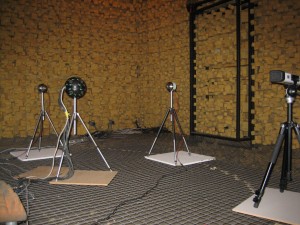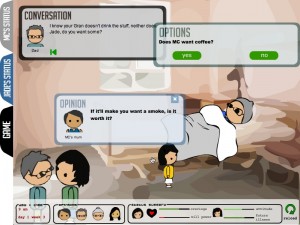Date: 31 October 2012
Time: 13.00-14.00
Place: NJ14 4-205
CANCELED
Research seminars in the Department of Architecture, Design and Media Technology
Date: 31 October 2012
Time: 13.00-14.00
Place: NJ14 4-205
CANCELED
 Date: 17 October 2012
Date: 17 October 2012
Time: 13.00-14.00
Place: NJ14 3-228 (Las Vegas)
The localization of noise is of interest in the car industry where a good mapping will make it much easier to find the sources generating the noise and thereby lower their output. The normal methods used are the delay-and-sum beam-forming and spherical harmonics beam-forming. These methods give a bad low frequency resolution and since much noise generated in a car is of low frequency these methods are not optimal. Here the mapping is done by solving an inverse problem with a transfer matrix between the volume velocity of the sources and the measured pressures at the microphone array. The problem is very ill-posed and therefore regularization have to be applied when the transfer matrix is inverted in order to give good results.
Bio
Sidsel Marie Nørholm got a Master Degree in Sound and Acoustic Technology at the Technical University of Denmark in August 2012. In September 2012 she started as a PhD student at ad:mt working at the project Spatio-Temporal Filtering Methods for Enhancement and Separation of Speech Signals.
 Date: 03 October 2012
Date: 03 October 2012
Time: 13.00-14.00
Place: NJ14 3-228 (Las Vegas)
In this study we introduce logistic regression as a method for modeling, in this case the user’s detection rate, to more easily show cross-effecting factors, necessary in order to design an adaptive system. Previously such effects have been investigated by a variety of linear regression type methods but these are not well suited for developing adaptive systems. We investigate the method on a qualitative and quantitative dataset with ages spanning from seven to 79 years under indoor and outdoor experimental settings. The results show that the method is indeed a suitable candidate for quantification of, in this instance vibrotactile information, and for the future design of user adaptive vibrotactile displays. More generally the model shows potential for designing a variety of adaptive systems.
Bio
Lars Knudsen finished his studies at medialogy the summer 2011 where his master thesis concerned tactile displays and navigation, supervised by Hans Jørgen Andersen and Ann Morrison. Afterwards he has continued studying the field of tactile displays, especially with a focus on modeling modeling vibrotactile sensitivities.
Suggestions for the fall program are welcome. Please send me an email with name, tentative title and approximate date: matthias AT create.aau.dk
Date: 30 May 2012
Time: 13.00-14.00
Place: NJ14 3-228 (Las Vegas)
A system for Do-It-Yourself (DIY) interface designs focused on sound and music computing has been developed. The system is based on the Create USB Interface (CUI), which is an open source microcontroller prototyping board together with the GROVE system of interchangeable transducers. Together, these provide a malleable and fluid prototyping process of ‘Sketching in Hardware’ for both music and non-music interaction design ideas. The most recent version of the board is the CUI32Stem, which is designed specifically to work hand- in-hand with the GROVE elements produced by Seeed Studio, Inc. GROVE includes a growing collection of open source sensors and actuators that utilize simple 4-wire cables to connect to the CUI32Stem. The CUI32Stem itself utilizes a high-performance Microchip® PIC32 microcontroller, allowing a wide range of programmable interactions. The development of this system and its use in sound and music interaction design is described. Typical use scenarios for the system may pair the CUI32Stem with a smartphone, a normal computer, and one or more GROVE elements via wired or wireless connections.
For more information, please see: http://www.seeedstudio.com/wiki/CUI32Stem
Three-dimensional (3D) user interfaces are popular in movies. There are also many current systems that enable people to interact with 3D content, including computer games. We re-investigate the ideas behind such 3D user interfaces and present innovative solutions based on the capabilities and limitations of both humans and technologies.
Bio
Dr. Stuerzlinger graduated with a Doctorate in Computer Science from the Technical University in Vienna, Austria in 1993. Then he moved to the Johannes Kepler University of Linz, Austria. Supported by an Erwin-Schrödinger fellowship Dr. Stuerzlinger visited the Department of Computer Science at the University of North Carolina in Chapel Hill in 1997 (hosted by Prof. F. Brooks). In 1998, Dr. Stuerzlinger was appointed to the Department of Computer Science at York University in Toronto, Canada. There, he is a full professor and a member of the interdisciplinary Centre for Vision Research (CVR).
While in Austria and at UNC, Dr. Stuerzlinger’s research interests concentrated on various areas of computer graphics, as well as parallel and high-performance systems. At York University he is leading the Interactive Systems Research Group. Dr. Stuerzlinger is a leading researcher in three-dimensional user interfaces and virtual reality. Additionally, he is very active in human-computer interaction. In general, his research aims to find innovative solutions for real-world problems and is often inter-disciplinary. Current research projects include better user interfaces for two-dimensional and three-dimensional design applications, meeting room environments that actively support collaboration, user interface techniques that are based on human perception principles, new virtual reality hardware and software, a novel kind of display system that can display very vivid images, and many other projects.
Dr. Stuerzlinger is a member of the GRAND NCE (Graphics, Animation and New Media Network of Centres of Excellence) board, a journal editorial board, and numerous international program committees. He has also chaired several international scientific events. He is an author of more than a dozen patents. Dr. Stuerzlinger has supervised more than 35 graduate students to completion and published more than 100 refereed scientific papers. His group currently consists of a postdoc and 10 graduate students.
 Date: 23 May 2012
Date: 23 May 2012
Time: 13.00-14.00
Place: NJ14 3-228 (Las Vegas)
Between 2007 and 2009 around 60.000 immigrants were coming to Denmark each year (Grunnet 2010). The main integration activities for these new citizens are language courses run by the communities, which are offered free of charge or with a minimal fee. The goal of these courses is to put the new comers into a position, where they can participate in everyday Danish life. But although the courses establish a thorough theoretical understanding of the language, they often lack the possibilities to motivate the students in their everyday activities to apply this knowledge in real cultural settings and thus to pro-actively participate in their host society.
To cope with this applicability problem, we suggest an approach based on our previous work on intercultural communication (e.g. Rehm et al. 2009) that puts the cultural and language learning task in the context of its actual use by embracing new and innovative training methods – like situated and experience-based learning – that have been shown to be more effective in terms of cultural integration (Landis et al 2004). Imagine e.g. a situation where the student stands in line at the train station in order to purchase a ticket. This can be seen as an ideal situation to trigger a Danish learning session on buying a train ticket. The student has some time for this session as he is waiting for his turn, he is in the right context for the knowledge that is conveyed and he is able to apply the knowledge shortly afterwards in a real situation.
The talk will be about presenting the idea and approach on how to incorporate a system/application, which will support this claim about how context based learning can be more effective in cultural integration. I hope to gain some insight from many of the “immigrants” that currently inhabit here on the department.
Bio
Søren Eskildsen graduated as M.Sc. from Medialogy in the summer 2011 at AAU Aalborg. With main focus on creating virtual environments with the purpose of investigating learning possibilities by using a more vivid approach to creating learning material. This idea has paved the way to Namibia to work on preserving indigenous knowledge for duration of 3½ weeks. His master thesis focused on learning from a virtual environment and measuring different activities like preferred media. He is currently employed as a Research assistant at Medialogy Aalborg, where the current project regarding cultural support in a learning context is being investigated. In addition he teaches Animation and Graphic Design on first semester as well as supervising on several semesters (2nd & 6th).
Date: 09 May 2012
Time: 13.00-14.00
Place: NJ14 4-107
Jamie will present the work and direction of CIID’s new Research group and discuss the particular situation that is Interaction Design Research within a private Institution that encompasses Consulting, Education and research interests. He will also present a series of his art-design and technology projects which develop ideas in the discovery of systems, and the possibility of fostering creative relationships to the systems and material complexes of technology.
http://heavyside.net/
http://ciid.dk/consulting/people/jamie-allen/
http://ciid.dk/
Bio
Jamie Allen is Head of Research at CIID and directs the strategy and focus of research and experimentation at the institute. He has taught at the Interactive Telecommunication from the Tisch School of the Arts, New York University, the Pratt Institute of Art and Design, the Kolding School of Design and others. Prior to his work with CIID, he was Assistant Direct of Culture Lab, Newcastle University developing artistic and technology initiatives. His own work is focused on intersections between art and design, technology and culture, people and knowledge. He has extensive industry experience and expertise in people-centered technologies, having worked with IBM, DuPont Inc., ESI Design and the American Museum of Natural History.
Date: 02 May 2012
Time: 13.00-14.00
Place: NJ14 3-228
We show that the autostereoscopic display of stereoscopic images using a static parallax barrier can be improved by adapting the rendering to the angle under which the user is looking at a mobile display; thus, ghosting artifacts and depth reversals can often be avoided even if the user tilts the mobile device. Instead of moving the barrier itself to compensate for a misplacement of the device in relation to the user, a pixel column shifting in software can provide a similar compensation. This requires a parallax barrier where each section covers two pixel columns at a time. The proposed method has been implemented using OpenGL shaders and a parallax barrier that was designed for a display of exactly half the resolution of the employed display. Technical tests showed a good left and right image separation with a viewing angle of up to 60 degrees. Preliminary user tests indicate that an improvement in stereo experience can be observed.
 Date: 23 April 2012 (Monday!)
Date: 23 April 2012 (Monday!)
Time: 13.00-14.00
Place: NJ14 4-107
Human culture and human cultural values are fundamental to all aspects of our lives. It is natural, then, to consider the impact of such a fundamental element of human life on video games. At present, the attention paid to human culture in game studies has tended to revolve around three areas: representations of culture and different cultural groups in video game worlds, appropriations of video games amongst cultural groups, and the development of subcultures within or around particular games and genres. Beyond considerations of human cultures and their representations and interactions with video games, however, we can draw further structural connections. Cross-cultural research
conceptualises human culture in terms of some of the same structures we often use to understand games. If we map video games to cultures, we can view play as actions within a culture that supports and encourages particular sets of values and modes of behaviour, while discouraging, disallowing, and punishing other sets of values and modes of behaviour. Just as in human cultures, cultural members learn to rely on cultural rules for survival and progression, within games, players learn to do the same.
In this talk, I will present the perspective that video games do and arguably must embody human culture and cultural values in both their representational and mechanical layers. I will show how cross-cultural psychology and descriptions of human values can be applied to video games to yield insight into the nature of our interactions with them. I will present how cultural values manifest themselves in two contrasting video games, The Sims 3 and Fallout 3, using the widely accepted cultural constructs of individualism and collectivism. In
addition, I will present a case study of a previous project concerning the design of the culturally-relevant persuasive game, Smoke? Following from the implications of the analyses and the case study, I will present new design directions as yet underdeveloped in current video games, particularly in the form of human cultural values from non-Western cultures.
Bio
Rilla Khaled is an assistant professor at the Center for Computer Games Research at the IT University of Copenhagen, and has a PhD in Computer Science from the Victoria University of Wellington in New Zealand. Her current research focuses on how to design more effective and meaningful serious and persuasive games, the interactions between
games and culture, how to adapt game design methods to foster creativity and design diversity, and humour in games. She is involved in a number of research projects, including the EU FP7-funded SIREN serious game project and the Danish-funded Games for Health project. Her previous PhD research focused on culturally-relevant persuasive games, and established that designing for cultural relevance leads to greater persuasion. As Rilla’s background is in software engineering and cross-cultural psychology, her interests extend from the software-level design and development of games up to their higher level effects on and as cultural practices.